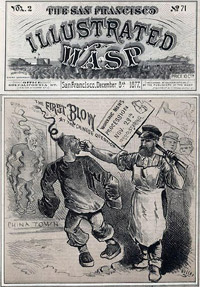










|
 |
| |
|

 |
Lesson Overview |
This section consists largely of primary sources that offer Chinese perspectives
on the issues and events covered in earlier lessons rather than an integrated
lesson that could stand on its own. The individual readings can be combined
with activities in earlier lessons in this unit or could be used in a general
lesson on immigration.
Objectives
-
Students will be able to explain how anti-Chinese sentiment and
the Exclusion Act affected the lives of Chinese immigrants and their families.
-
Students
will be able to give examples of ways in which Chinese immigrants responded
to the prejudice and discrimination they faced.
-
Students will be able to
identify and evaluate differing points of view regarding the enforcement
of the Exclusion Act.
-
Students will analyze population data to see the effects of exclusion and
the immigration of paper sons and daughters on the Chinese population in
the United States from the 1860s to the end of the 20th century.

The First Blow at the Chinese Question
Adapting the Lesson for Middle School
Most
of the readings in this lesson would be appropriate for middle school students.
The Lee Chew reading is lengthy, but easy to read. The Paper Sons activity
involves an interview that students can role play with a partner. The folk
songs and poems can be read out loud and discussed in class. The questions
and writing assignment that accompany the anti-Chinese Riot handout are geared
towards high school students, but middle school students may still find
the primary sources interesting to read.
|
 |


|